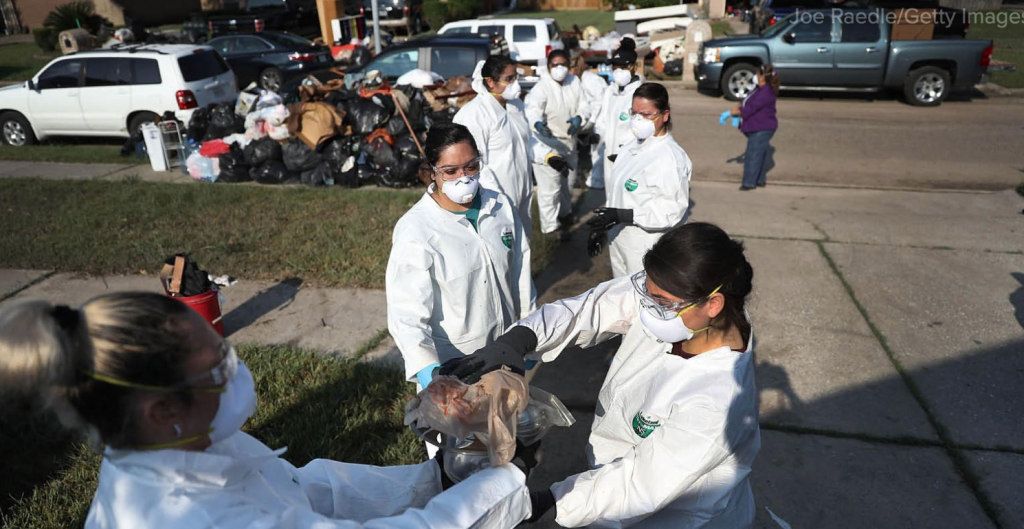How You Can Get Rid of and Recycle Post-Florence Storm Debris
Even as the remnants of Hurricane Florence pulled away from the Carolinas earlier this week, residents and businesses in both North and South Carolina are continuing to struggle through the aftermath of the storm.
Florence dumped record-breaking rainfall throughout the Carolinas, which produced devastating floods in the area. According to an AccuWeather report, the highest amount of rainfall—35.93 inches—was recorded near Elizabethtown, N.C. In addition, Florence dumped nearly 2 feet of rain in Wilmington, N.C. The storm has led to at least 32 deaths and hundreds of water rescues, according to the report.
And storms like this can have a lingering effect on the waste and recycling industry in devastated areas. Here’s a look at what some solid waste and recycling companies are doing to help communities recover, as well as some post-storm tips they are offering.
Republic Services
The Republic Services team is working hard to support the communities affected by Hurricane Florence. As recovery efforts get underway, Republic offers the following tips to help with trash collection, recycling and removal of storm debris.
- Keep household trash and recycling separate from storm debris.Materials such as tree branches, drywall and waterlogged electronics or appliances should not go in trash or recycling containers. These materials typically are picked up by separately contracted storm debris removal companies.
- Storm debris should never be placed in garbage bags. Bags prevent storm debris removal companies from seeing what’s inside and may result in the bags being left behind. Instead, place storm debris at the curb in separate piles, such as large appliances, electronics, construction materials, hazardous waste or yard waste. Be sure not to block roadways or storm drains.
- Republic said it stands ready to continue to collect solid waste and recycling as soon as roads are clear. In most cities, storm debris is separately contracted under the Federal Emergency Management Agency’s disaster assistance, based on assessments from local emergency managers. Debris pickup will be separate from regular waste and recycling collection.
Republic also noted it is in the process of resuming regular residential and commercial collection services in the impacted areas. For updates about waste and recycling collection schedules, visit Republic’s website or the company’s My Resource app for iOS or Android.
For additional details and a visual guide to preparing storm debris for pickup, refer to the company’s debris removal guidelines.
Waste Management
At the start of hurricane season, Waste Management released some useful storm preparation tips for before and after a major storm. Once a storm has passed, there are a number of things that can be done to ensure the smooth resumption of trash and recycling collection services.
- Separate regular household waste from storm debris. Everyday items, like food, recyclables and other household waste, should be treated as you normally would, while storm debris, including tree limbs, soiled carpeting, damaged fencing and appliances, should be placed curbside in separate piles.
- Separating properly will allow Waste Management to collect household garbage more quickly and safely and help prevent odors and other safety hazards from impacting surrounding areas. Separation is also necessary to allow other firms to collect storm debris in accordance with arrangements made by local municipalities, counties or FEMA.
- Waste Management will restart curbside trash and recycling collection of normal household waste as soon as it is safe to do so.
Quest Resource Holding
Quest Resource Holding Corporation launched a Natural Disaster Waste Management Recovery program that responds to catastrophic events and provides emergency cleanup services across the United States.
Quest tracks incoming storms and leverages its network of subcontractors to deploy comprehensive debris removal solutions, extensive hazardous waste treatment and critical cleanup services to help its customers and participating affected communities quickly recover from the natural disaster and rebuild their operations.
“Disasters can generate several years’ worth of a community’s solid waste in just a few days, which can easily overwhelm any local solid waste removal operation,” said Ray Hatch, Quest’s CEO, in a statement. “Quest’s rapid deployment solution provides effective emergency response relief to businesses dealing with the aftermath of a national disaster.”
Waste Pro of Florida
Waste Pro of Florida also released hurricane preparedness and sanitation service tipsfor before, during and after a storm. Here are a few post-storm tips the company released:
- Be prepared for adjustments to sanitation schedules after a hurricane.
- Put all trash in an accessible area away from power lines, fences and trees.
- Advise Waste Pro and utility companies of any downed power lines in the area.

